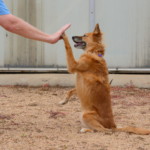Introduction
In the realm of therapeutic interventions, the role of dogs in animal-assisted therapy is garnering attention for its remarkable impact on emotional and physical well-being. This article aims to delve into the profound influence of our furry friends in therapy settings, exploring the benefits, challenges, and practical solutions associated with animal-assisted therapy.
The Healing Bond Between Humans and Dogs
In the realm of therapeutic interventions, the profound connection between humans and dogs serves as the cornerstone of successful animal-assisted therapy (AAT). Understanding the intricate bond that forms between individuals and their canine companions unveils a therapeutic dynamic that goes beyond conventional treatments.
The science behind the human-animal bond is deeply rooted in the physiological and psychological responses triggered by the presence of dogs. Interactions with dogs stimulate the release of oxytocin, often referred to as the “love hormone,” fostering feelings of trust and affection. This hormonal surge is reciprocal, occurring in both humans and their canine counterparts, creating a reciprocal and emotionally enriching experience.
Moreover, the human-animal bond is linked to the reduction of stress-related hormones such as cortisol, leading to a calmer and more relaxed state of being. The rhythmic and comforting presence of a dog can mitigate anxiety, elevate mood, and provide a source of unconditional support.
In the context of animal-assisted therapy, this bond becomes a therapeutic tool with far-reaching implications. The presence of a well-trained and empathetic therapy dog can break down emotional barriers, creating a comfortable and non-judgmental space for individuals to express themselves. This is particularly beneficial for those facing challenges such as trauma, anxiety, or loneliness.
The therapeutic implications of the human-animal bond extend to various domains, including mental health, rehabilitation, and emotional well-being. Studies have demonstrated the positive impact of AAT on individuals with conditions like post-traumatic stress disorder (PTSD), autism spectrum disorders, and chronic pain.
Benefits Across the Spectrum
Dogs in therapy play a pivotal role in fostering a multitude of benefits, extending their impact across mental health improvements to aiding in physical rehabilitation. Real-life cases and scientific studies consistently underline the positive outcomes that arise from integrating dogs into various therapy sessions.
In the realm of mental health, the presence of therapy dogs has been linked to reduced stress, anxiety, and depression. Interactions with these furry companions trigger the release of oxytocin, promoting feelings of trust and well-being. In cases of post-traumatic stress disorder (PTSD), therapy dogs provide crucial support, offering a sense of security and comfort to individuals navigating the challenges of trauma.
Studies have also illuminated the positive impact of dogs in therapy for children with autism spectrum disorders. The non-judgmental and comforting nature of dogs creates an environment conducive to social interaction and emotional expression. Many children find solace and companionship in therapy dogs, aiding in their overall development and communication skills.
In the context of physical rehabilitation, dogs prove to be invaluable partners. Their innate ability to motivate individuals to engage in physical activities enhances the effectiveness of rehabilitation sessions. Patients recovering from surgeries or injuries often experience improved mobility and strength through activities involving therapy dogs.
Real-life cases exemplify the transformative power of dogs in therapy. Veterans recovering from war-related trauma, elderly individuals grappling with loneliness, and children facing developmental challenges have all witnessed remarkable improvements through interactions with therapy dogs.
Challenges and Solutions
Implementing animal-assisted therapy comes with its unique set of challenges, ranging from allergies and fear of dogs to logistical issues. However, these challenges can be effectively addressed through thoughtful strategies, ensuring a smooth and successful therapy experience.
One common challenge is allergies among clients or staff involved in therapy sessions. To mitigate this, implementing a thorough screening process is crucial. Before introducing dogs into a therapeutic environment, individuals can be screened for allergies through health assessments. Additionally, practitioners can consider hypoallergenic dog breeds or those with minimal shedding tendencies to minimize the risk of allergic reactions.
Fear of dogs is another obstacle that may arise during animal-assisted therapy. It is imperative to create a safe and gradual introduction for individuals with fear or anxiety around dogs. This can involve educational initiatives, such as providing information about the temperament and behavior of therapy dogs. Practitioners may also begin sessions with non-threatening interactions, gradually progressing to more direct contact as the individual becomes more comfortable.
Logistical issues, such as space constraints or facility limitations, can hinder the implementation of animal-assisted therapy. Addressing these challenges requires facility adaptations and careful planning. Creating designated and comfortable spaces for therapy sessions, ensuring proper hygiene and sanitation practices, and collaborating with facility management can help overcome logistical hurdles.
Educational initiatives play a pivotal role in addressing both allergies and fear of dogs. Providing information about the benefits of animal-assisted therapy, the training and certification of therapy dogs, and the protocols in place for ensuring a safe environment can help alleviate concerns and build confidence in the therapeutic process.
Guidelines for Successful Implementation
Integrating dogs into therapy settings requires careful consideration and adherence to guidelines to guarantee the safety and effectiveness of therapy sessions. This involves collaboration among therapists, healthcare professionals, and skilled dog handlers who play a pivotal role in the success of animal-assisted therapy programs.
First and foremost, the selection and training of therapy dogs are critical components. Therapists and dog handlers should prioritize dogs with calm temperaments, gentle demeanors, and a natural affinity for human interaction. These dogs must undergo rigorous training programs to ensure they respond appropriately to various situations encountered during therapy sessions.
Certification is another crucial step in the integration process. Therapy dogs should be certified by recognized organizations that assess their behavior, obedience, and suitability for therapeutic work. Certification ensures that the dog and its handler meet specific standards, guaranteeing a level of professionalism and competence in the therapy setting.
Ongoing evaluation is essential for maintaining the quality and safety of therapy sessions. Regular assessments of both the therapy dog and its handler help identify any changes in behavior, health, or performance that may impact the effectiveness of the therapy program. Continuous training and professional development for handlers contribute to the overall success of the therapy team.
Clear communication and collaboration between therapists, healthcare professionals, and dog handlers are paramount. Therapists should provide specific guidelines for dog interaction during sessions, considering the unique needs and sensitivities of each client. Open dialogue ensures that everyone involved is on the same page, fostering a cohesive and effective therapeutic environment.
Conclusion
In conclusion, the transformative power of dogs in animal-assisted therapy is undeniable. From enhancing emotional well-being to aiding in physical recovery, therapy tails leave an indelible mark on those seeking healing. By understanding the benefits, overcoming challenges, and following best practices, we can continue to harness the incredible potential of dogs in the therapeutic journey.









